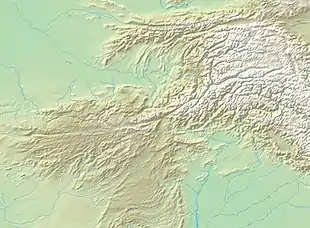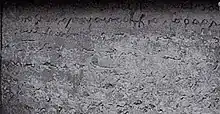
Alkhis was a ruler of the area of Zabul, with its capital at Gazan (Ghazni) in Afghanistan in the early decades of the 8th century CE.[3] He was the son of Khuras.[3] He expanded his territory as far north of the region of Band-e Amir, west of Bamiyan.[3] Although not listed in contemporary Chinese sources, Alkhis may have been a member of the Zunbil ruler of Zabulistan, and was probably of the same ethnicity as the nearby Turk Shahis ruling in Kabul at that time.[4]
Alkhis is known to have sent a message to the Tang dynasty emperor in 724 CE.[3] Before 726 CE, he made the territory of Zabul independent from the kingdom of Jibin-Kabul ruled by the Turk Shahis.[3]
Alkhis is considered as the patron of the second period of florescence of the Buddhist sanctuary of Tapa Sardar, characterized in this period by the creation of hybrid Sinicized-Indian Buddhist art.[3]
The Bactrian inscription of the stupa at Tang-i Safedak (34°44′16″N 66°45′50″E / 34.737663°N 66.763899°E), dated to around 715/716 CE or 710/724 CE, mentions the dedication of a stupa by Alkhis:[5]
Tang-i Safedak inscription"(It was) the year 492, the month Sbol, when I, Alkhis son of Khuras, lord of Gazan, established this stupa (as) a (pious) foundation(?) in Ragzamagan(?). (At that time) when there was a Turkish ruler and an Arab ruler, the deyadharma (meritorious gifts) made by me were kept . . . , and afterwards I made this Zinaiaka-deyadharma in the willing belief which I had towards the huddha-sastra and in great faith (Sraddha) and in ... Whatever merit (punya ) may arise hereby, now and (in) the future, may I, Alkhis, and my parents and wife and brothers (and) sons and (other) relatives too-may each (and) every one (of us) attain (his) own desire. Homage to the buddhas."
External links
References
- ↑ Lee, Jonathan L.; Sims Williams, Nicholas (2003). "Bactrian Inscription from Yakawlang sheds new light on history of Buddhism in Afghanistan". Silk Road Art and Archaeology. 9: 172–172.
- ↑ "Late Hunnic, Turkic and Arab-Hephthalite Issues, page 7". grifterrec.org.
- 1 2 3 4 5 6 Verardi, Giovanni; Paparatti, Elio (2005). "From Early to Late Tapa Sardār: A Tentative Chronology". East and West. 55 (1/4): 433. ISSN 0012-8376. JSTOR 29757657.
- 1 2 Lee, Jonathan L.; Sims Williams, Nicholas (2003). "Bactrian Inscription from Yakawlang sheds new light on history of Buddhism in Afghanistan". Silk Road Art and Archaeology. 9.
- ↑ Alram, Michael (1 February 2021). "The Numismatic Legacy of the Sasanians in the East", in Sasanian Iran in the Context of Late Antiquity: The Bahari Lecture Series at the University of Oxford. BRILL. p. 13. ISBN 978-90-04-46066-9.

